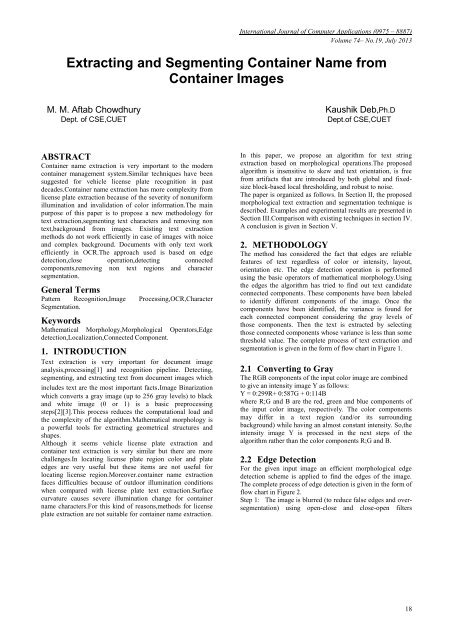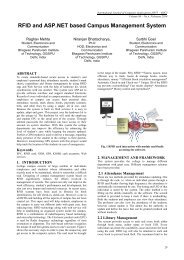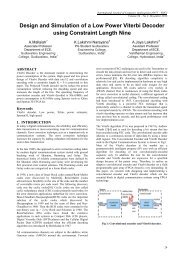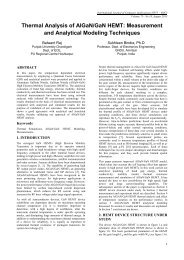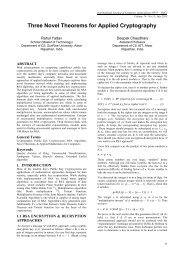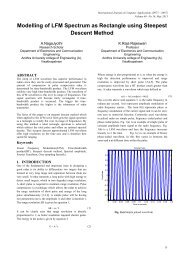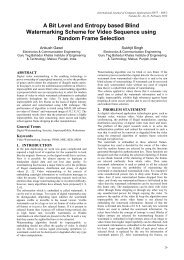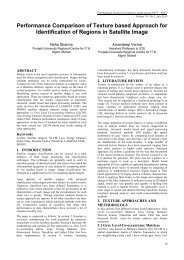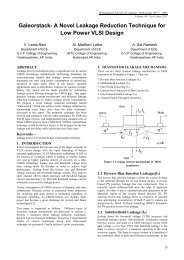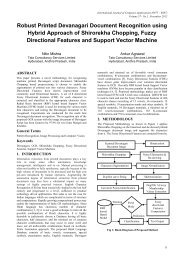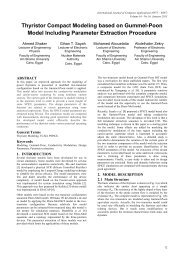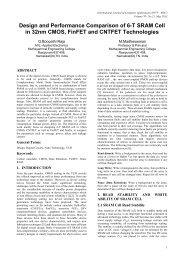Extracting and Segmenting Container Name from Container Images
Extracting and Segmenting Container Name from Container Images
Extracting and Segmenting Container Name from Container Images
You also want an ePaper? Increase the reach of your titles
YUMPU automatically turns print PDFs into web optimized ePapers that Google loves.
International Journal of Computer Applications (0975 – 8887)<br />
Volume 74– No.19, July 2013<br />
<strong>Extracting</strong> <strong>and</strong> <strong>Segmenting</strong> <strong>Container</strong> <strong>Name</strong> <strong>from</strong><br />
<strong>Container</strong> <strong>Images</strong><br />
M. M. Aftab Chowdhury<br />
Dept. of CSE,CUET<br />
Kaushik Deb,Ph.D<br />
Dept.of CSE,CUET<br />
ABSTRACT<br />
<strong>Container</strong> name extraction is very important to the modern<br />
container management system.Similar techniques have been<br />
suggested for vehicle license plate recognition in past<br />
decades.<strong>Container</strong> name extraction has more complexity <strong>from</strong><br />
license plate extraction because of the severity of nonuniform<br />
illumination <strong>and</strong> invalidation of color information.The main<br />
purpose of this paper is to propose a new methodology for<br />
text extraction,segmenting text characters <strong>and</strong> removing non<br />
text,background <strong>from</strong> images. Existing text extraction<br />
methods do not work efficiently in case of images with noice<br />
<strong>and</strong> complex background. Documents with only text work<br />
efficiently in OCR.The approach used is based on edge<br />
detection,close operation,detecting connected<br />
components,removing non text regions <strong>and</strong> character<br />
segmentation.<br />
General Terms<br />
Pattern Recognition,Image Processing,OCR,Character<br />
Segmentation.<br />
Keywords<br />
Mathematical Morphology,Morphological Operators,Edge<br />
detection,Localization,Connected Component.<br />
1. INTRODUCTION<br />
Text extraction is very important for document image<br />
analysis,processing[1] <strong>and</strong> recognition pipeline. Detecting,<br />
segmenting, <strong>and</strong> extracting text <strong>from</strong> document images which<br />
includes text are the most important facts.Image Binarization<br />
which converts a gray image (up to 256 gray levels) to black<br />
<strong>and</strong> white image (0 or 1) is a basic preprocessing<br />
steps[2][3].This process reduces the computational load <strong>and</strong><br />
the complexity of the algorithm.Mathematical morphology is<br />
a powerful tools for extracting geometrical structures <strong>and</strong><br />
shapes.<br />
Although it seems vehicle license plate extraction <strong>and</strong><br />
container text extraction is very similar but there are more<br />
challenges.In locating license plate region color <strong>and</strong> plate<br />
edges are very useful but these items are not useful for<br />
locating license region.Moreover.container name extraction<br />
faces difficulties because of outdoor illumination conditions<br />
when compared with license plate text extraction.Surface<br />
curvature causes severe illumination change for container<br />
name characters.For this kind of reasons,methods for license<br />
plate extraction are not suitable for container name extraction.<br />
In this paper, we propose an algorithm for text string<br />
extraction based on morphological operations.The proposed<br />
algorithm is insensitive to skew <strong>and</strong> text orientation, is free<br />
<strong>from</strong> artifacts that are introduced by both global <strong>and</strong> fixedsize<br />
block-based local thresholding, <strong>and</strong> robust to noise.<br />
The paper is organized as follows. In Section II, the proposed<br />
morphological text extraction <strong>and</strong> segmentation technique is<br />
described. Examples <strong>and</strong> experimental results are presented in<br />
Section III.Comparison with existing techniques in section IV.<br />
A conclusion is given in Section V.<br />
2. METHODOLOGY<br />
The method has considered the fact that edges are reliable<br />
features of text regardless of color or intensity, layout,<br />
orientation etc. The edge detection operation is performed<br />
using the basic operators of mathematical morphology.Using<br />
the edges the algorithm has tried to find out text c<strong>and</strong>idate<br />
connected components. These components have been labeled<br />
to identify different components of the image. Once the<br />
components have been identified, the variance is found for<br />
each connected component considering the gray levels of<br />
those components. Then the text is extracted by selecting<br />
those connected components whose variance is less than some<br />
threshold value. The complete process of text extraction <strong>and</strong><br />
segmentation is given in the form of flow chart in Figure 1.<br />
2.1 Converting to Gray<br />
The RGB components of the input color image are combined<br />
to give an intensity image Y as follows:<br />
Y = 0:299R+ 0:587G + 0:114B<br />
where R;G <strong>and</strong> B are the red, green <strong>and</strong> blue components of<br />
the input color image, respectively. The color components<br />
may differ in a text region (<strong>and</strong>/or its surrounding<br />
background) while having an almost constant intensity. So,the<br />
intensity image Y is processed in the next steps of the<br />
algorithm rather than the color components R;G <strong>and</strong> B.<br />
2.2 Edge Detection<br />
For the given input image an efficient morphological edge<br />
detection scheme is applied to find the edges of the image.<br />
The complete process of edge detection is given in the form of<br />
flow chart in Figure 2.<br />
Step 1: The image is blurred (to reduce false edges <strong>and</strong> oversegmentation)<br />
using open-close <strong>and</strong> close-open filters<br />
18
International Journal of Computer Applications (0975 – 8887)<br />
Volume 74– No.19, July 2013<br />
s = max( g1 ∗∗ es , g2 ∗∗ es )<br />
Where, g1 = [−1 0 1] , g2 = transpose[−1 0 1] , <strong>and</strong> “**”<br />
denotes two-dimensional linear convolution.The binary edge<br />
image (e) is then given by<br />
e = 0, oterwise<br />
1, es > ɣ<br />
(a)<br />
Fig 1: Flow Chart for Text Extraction<br />
The final blurred image is the average of the outputs of these<br />
filters.<br />
Step 2: Morphological gradient (MG) operator is applied to<br />
the blurred image Ybl resulting in an image es as follows:<br />
es = δB(Ybl) - εB(Ybl)<br />
Where, B is connected structuring element,δB is dilation with<br />
B on Ybl , εB is erosion with B on Ybl.<br />
(b)<br />
Fig 3: (a)Input Image,(b)Edge detection<br />
2.3 Close Operation<br />
Close edges in the binary edge image e are grouped by<br />
dilation using eight-connected structuring elements. Then,<br />
small connected components in the dilated image are filtered<br />
using erosion. The output is a binary image ec that contains<br />
text c<strong>and</strong>idate regions.<br />
Fig 2:Flow Chart for Edge Detection<br />
Step 3: The resulting image es is then thresholded to obtain a<br />
binary edge image. The threshold level ɣ is determined by<br />
ɣ =<br />
(es.s)<br />
s<br />
where “.” denotes pixel-wise multiplication <strong>and</strong> s is given<br />
by<br />
Fig 4:Close Operation<br />
2.4 Labelling of Text Regions<br />
All connected components of the edge image are screened<br />
with their position,size <strong>and</strong> area information.In our,algorithm<br />
we select connected components as a letter c<strong>and</strong>idates if the<br />
following reqirements are met:<br />
19
International Journal of Computer Applications (0975 – 8887)<br />
Volume 74– No.19, July 2013<br />
1. 0.01
International Journal of Computer Applications (0975 – 8887)<br />
Volume 74– No.19, July 2013<br />
Fig 8:Some example of container name extraction <strong>and</strong> segmentation<br />
21
International Journal of Computer Applications (0975 – 8887)<br />
Volume 74– No.19, July 2013<br />
4. COMPARISON WITH OTHER TEXT<br />
EXTRACTION TECHNIQUES<br />
To evaluate the performance there is a comparison with two<br />
existing algorithms [9] <strong>and</strong> [10].The first method has used a<br />
complicated method for finding inner,outer <strong>and</strong> inner-outer<br />
corners.<br />
The second procedure has extracted text by identify edge at<br />
different orientation i.e 0,45,90,135 degrees <strong>and</strong> grouping<br />
these strokes at different heights.So it is difficult to identify<br />
the edges at different orientation.To solve the problems<br />
Conneted Component Variance(CCV) has used.<br />
For finding a meaningfull word the isolated characters are<br />
grouped by dilation operation.The algorithm identifies each<br />
connected component <strong>and</strong> measures there properties.If the<br />
properties are not match with the properties in section 2.4 then<br />
it is symbol not character.<br />
5. CONCLUSION<br />
In this paper,we present a algorithm which is suitable to<br />
extract the container name of different colors,sizes <strong>and</strong><br />
alignment modes.The experiments with container images<br />
captured <strong>from</strong> the real port environment demonstrate the<br />
effectiveness of the proposed technique.<br />
Future work will focus on extracting container name <strong>from</strong><br />
multiple images captured <strong>from</strong> the same container with one or<br />
multiple cameras during its moving.The container images are<br />
captured at the different positions or different time.<br />
6. REFERENCES<br />
[1] K. Jain <strong>and</strong> B. Yu, “Document representation <strong>and</strong> its<br />
application to page decomposition,” IEEE Trans. Pattern<br />
Anal. Machine Intell., vol. 20, pp. 294–308, Mar. 1998.<br />
[2] J. Ohya, A. Shio, <strong>and</strong> S. Akamatsu, “Recognizing<br />
characters in scene images,” IEEE Trans. Pattern Anal.<br />
Machine Intell., vol. 16, pp. 215–220, Feb. 1994.<br />
[3] H. M. Suen <strong>and</strong> J. F.Wang, “Text string extraction <strong>from</strong><br />
images of colorpriented documents,” Proc. Inst. Elect.<br />
Eng. Vis.,Image, Signal Process., vol. 143, no. 4,<br />
pp.210–216,1996.<br />
[4] Nobuyuki Otsu, A threshold selection method <strong>from</strong> graylevel<br />
histograms. IEEE Trans.Sys.,Man., Cyber 9(1):62-<br />
66.<br />
[5] Y. K. Ham, M. S. Kang, H. K. Chung, <strong>and</strong> R. H. Park,<br />
“Recognition of raised characters for automatic<br />
classification of rubber tires,” Opt. Eng.,vol. 34, pp. 102–<br />
108, Jan. 1995.<br />
[6] R. Lienhart, “Indexing <strong>and</strong> retrieval of digital video<br />
sequences based on automatic text recognition,” in Proc.<br />
ACM Int. Conf., Boston, MA, Nov.1996.<br />
[7] L. Wang <strong>and</strong> T. Pavlidis, “Direct gray-scale extraction of<br />
features for character recognition,” IEEE Trans. Pattern<br />
Anal. Machine Intell., vol.15, pp. 1053–1067, Oct. 1993.<br />
[8] Y. Zhong, K. Karu, <strong>and</strong> A. K. Jain, “Locating text in<br />
complex color images,” Pattern Recognit., vol. 28, no.<br />
10, pp. 1523–1535,1995.<br />
[9] Jagath Samarab<strong>and</strong>u, Member, IEEE, <strong>and</strong> Xiaoqing Liu<br />
2007 “An Edge-based Text Region Extraction Algorithm<br />
for Indoor Mobile Robot Navigation” ,International<br />
Journal of Signal Processing 3(4 )2007.<br />
[10] Yassin M. Y. Hasan <strong>and</strong> Lina J. Karam 2000<br />
“Morphological Text Extraction <strong>from</strong> <strong>Images</strong>” IEEE<br />
Transaction on Image Processing vol. 9,no.11,Nov.2000<br />
IJCA TM : www.ijcaonline.org<br />
22


